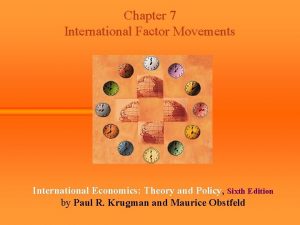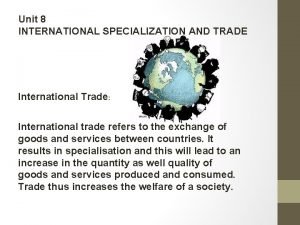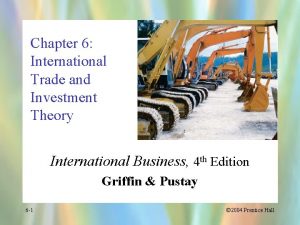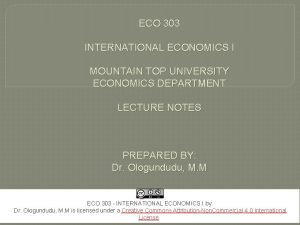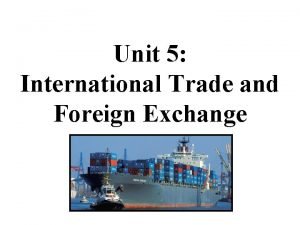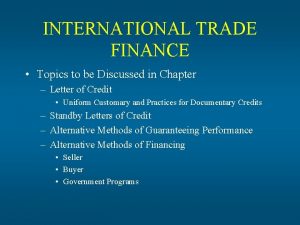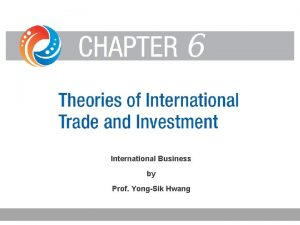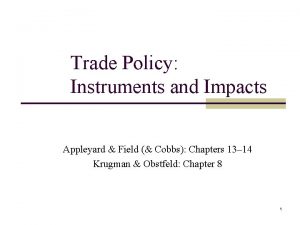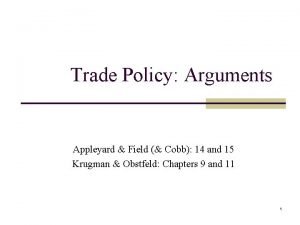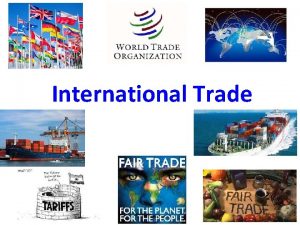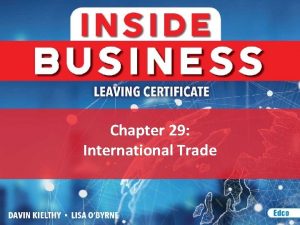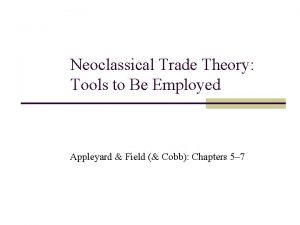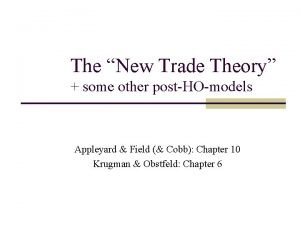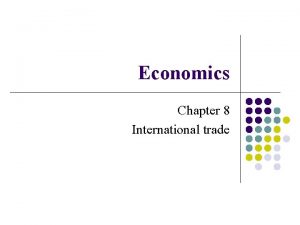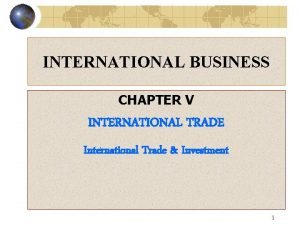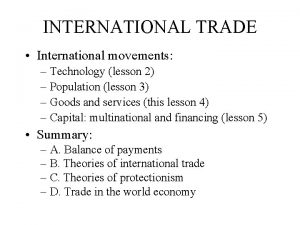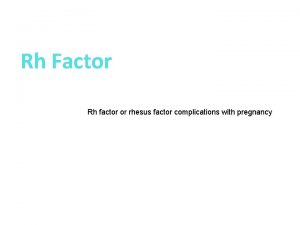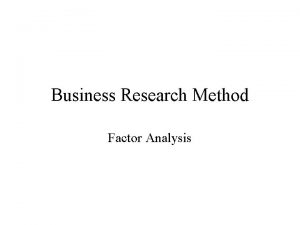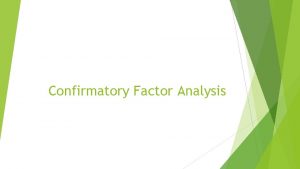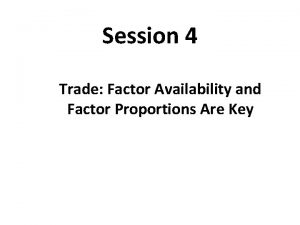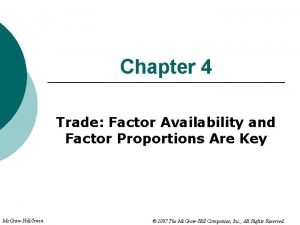Growth and Trade International Factor Movements Appleyard Field
























- Slides: 24

Growth and Trade, International Factor Movements Appleyard & Field (& Cobb): Chapters 11– 12 Krugman & Obstfeld: Chapter 7

Growth • Economic growth may be due to change in o technology o amounts of factors of production o institutions (e. g. allowing international trade) • Impact of this change o producers need to decide how to alter production o consumer need to decide how the change consumptions o world prices may change 2

Growth and PPF Clothes factor-neutral technological change or capital and labour increase by the same rate Paper labour saving technological change or increase of labour force Paper capital saving technological change or increase of capital Clothes 3

Terminology: Production Effects • • Assume a small country (=cannot affect world prices) exporting clothes Let there then be an increase in the production possibilities Producers select a point from the new PPF, and the production effect may be o neutral: production of exports and import-competing products grow at the same rate o protrade: production of exports increase relatively more o antitrade: production of importcompeting products increase relatively more neutral effect Paper (import) • “ultraantitrade” effect antitrade effect protrade effect “ultraprotrade effect” Clothes (export) 4

Terminology: Consumption Effects Paper • Similarly consumption effects o (ultra)protrade: consumption of imports increases more than consumption of exports = larger part of income will be spent on imports after growth imports o (ultra)anti-trade: as above, but after imports the other way around before o neutral: no change in the relative consumption pattern • The total impact of growth on trade depends on the combined production and consumption effects Note that we are assuming constant prices at this point exports before after Clothes 5

• • • Assumptions: constant prices (small-country), non-neutral growth in factors Growth in one factor leads to an absolute expansion in the output of product that uses that factor intensively and absolute contraction in output of the product that uses the other factor intensively Why? Relative factor prices cannot change since we assume constant product prices → K/L ratios of the industries must remain constant → capital must flow to the labour intensive sector Paper Rybczynski Theorem Growth of labour force → absolute increase in the labourintensive product (clothes) and an absolute decrease in the production of capital-intensive product (paper) Clothes 6

The Large country case: Change in World Prices • Large country = influences • Assume e. g. that growth in the abundant factor (labour) leads to pro-trade production effect and neutral consumption effect • Then, for any given prices, Imports of good Y world prices OC 1 OC 0 (PX/PY)1 (PX/PY)2 the country produces more exports and buys more imports = shift of the offer curve Exports of good X 7

New equilibrium: • More trade • New terms of trade = new relative prices • (PX/PY)E’ < (PX/PY)E Good Y: Imports to country 1 exports from country 2 Shift of Offer Curves (2) (PX/PY)E = TOTE (PX/PY)E’ = TOTE’ Country 2’s offer curve Country 1’s offer curves Good X: Exports from country 1 Imports to country 2 8

Terms of Trade Effect are lost due to reduction in terms of trade • That is, the price of exports decrease due to increased supply of exports o Paper • Part of the gains from trade alternatively price of imports increases due to increased demand of imports TOT 1 TOT 0 Clothes 9

Immiserizing Growth of trade is so large that country’s welfare decreases due to increase of a factor of production / improvement in technology Paper • The reduction in terms TOT 1 TOT 0 Clothes 10 Jagdish Bhagwati (1958): Immiserizing Growth: A Geometrical Note. Review of Economic

Foreign Direct Investment (FDI) • Definition: ownership and control of foreign capital o An foreign investment is recorded as FDI if it involves buying more than 10 percent of the outstanding common stock of a foreign firm o Otherwise the investment is classified as portfolio investment • The growth of FDI has been dramatically faster than the growth in merchandise trade during the past few decades • Here we are studying the impact of increase in physical capital due to FDI 11

Reasons for FDI 1. Getting close to the final markets 2. Access to raw materials 3. Low labour cost 4. Risk Diversion 5. Firm-specific knowledge 6. Trade policy (“getting behind the tariff wall”) etc. 12

Analyzing FDI • Assume two countries, two factors of production (labour and capital) and a single homogeneous good with free international movement of capital • Assume that the marginal physical product of capital (MPPK) is decreasing (when labour is held constant) • Remember: r=MPPKX*PX Note that we keep the amount of MPPK labour fixed and hence the marginal product of capital is decreasing Capital 13

Capital Market Equilibrium: Two Countries, Free Capital Mobility Country 1 MPPK Country 2 r 1 r 2 K 1 Capital r 2 K 2 14

Capital Market Equilibrium: Two Countries, Free Capital Mobility In autarky, capital is scarce in country 1 and hence return of capital is higher than in the capitalabundant country 2 è When capital movements are allowed, capital flows from 2 to 1 as long as it can get higher return in country 1 è In equilibrium, capital returns must be the same in both countries, which implies that MPPK 1=MPPK 2 Country 1: MPPK, r • Country 1’s eq’m capital Country 2: Country 2’s MPPK, r eq’m capital r. A 1 r* r* r. A 2 capital flow Country 1’s initial capital Country 2’s initial capital Total world capital 15

Presenting Output Geometrically • The amount of production depends on the amount of inputs and the marginal productivity of inputs: Y=MPPK*K+MPPL*L • Remember what area means Country 1: MPPK, r r. A 1 output (e. g. area of a square is x*y) • Thus, when we hold labour constant, we can study the effect of changes in capital on output via the area below the MPPK curve MPPK Country 1’s capital 16

Effect of Capital Flows in the Two Country Model • • Country 1’s output increases more than country 2’s output decreases → World output increases as a result of more efficient use of world resources In country 1, capital owners lose (return on capital decreases) and labour wins (increased capital increases their Country 1: MPPK, r Country 1’s eq’m capital Country 2: Country 2’s MPPK, r eq’m capital r. A 1 r* increase of world output r* productivity and hence wages) • In country 2, the opposite occurs o r. A 2 increase decrease of ofoutput in in country 1 2 we discuss this in more detail in the part about migration of labour Country 1’s initial capital Country 2’s initial capital Total world capital 17

Possible Benefits from Capital Flows for the Host Country 1. Increased output and wages (as discussed already) 2. Increased employment (if excess supply of labour exists) 3. Increased exports (usually, though not necessarily the case) 4. Increased tax revenues (if feasible tax policy exits) 5. Realization of scale economies 6. Technical and managerial skill spill- offs See Appleyard and Field (around page 231) for discussion 18

Possible Disadvantages from Capital Flows for the Host Country 1. Adverse terms-of-trade effect (if the country is large enough 2. Decreased domestic saving (“government relaxes its efforts to 3. Crowding out domestic investment (domestic investors could 4. Instability of exchange rate (when investment flows in the currency 5. 6. 7. Loss of control over domestic policy Increased unemployment (investment in capital-intensive techniques) New local monopolies (if multinationals run local firms out of 8. Inadequate attention to local education and skills exporter of the goods FDI flows into or due to transfer pricing) generate domestic savings”) finance multinationals rather than domestic business) appreciates; when profits are sent back, the currency depreciates) business) Note that many of the possible benefits & disadvantages are things that we are assuming away in our simple models. Hence we need other models to analyze these possible effects. 19 Models suitable for analyzing some of these effects are introduced later in the course.

International Labour Movements • Assume homogeneous labour, no costs of migration, no preferences regarding the country of residence • Then we can proceed as with capital: country 1 is labourabundant, country 2 labourscarce → wages are higher in country 2 → there is an incentive to move to country 2 until wages are equal Country 1: MPPL, w Country 1’s eq’m employment Country 2: Country 2’s MPPL, w eq’m employment w. A 2 w* w* w. A 1 migration Country 1’s initial employment Country 2’s initial employment Total world labour force 20

Distribution of income: a geometrical representation • The amount of production Country 1: MPPL, w depends on the amount of inputs and the marginal productivity of inputs: Y=MPPK*K+MPPL*L MPPL=(Y-MPPK*K)/L • Competitve labour market → w=MPPLX*PX • Labour gets w*L, capital owners get the rest w rents wages MPPL labour 21

Impact of Migration Country 1’s eq’m employment Country 2: Country 2’s MPPL, w eq’m employment w. A 2 w* im m su igr rp ati lu on s Country 2: (receiving immigrants) • wages decrease → transfer of income from labour to capital owners • total output increases more than what is paid to the immigrants → immigration surplus • However, there is a decrease in per capita output (given diminishing marginal productivity) Country 1: • wages increase → transfer of income from capital to labour • total output decreases more than the wage sum of those who left → immigration deficit • But, there is a increase in per capita output (given diminishing marginal productivity) Country 1: MPPL, w transfer from capital to labour in country transfer from labour to capital in country 1 w* gain for the immigrants w. A 1 Country 1’s initial employment Country 2’s employment Total world labour force 22

alter the factor endowments of an economy • This can be analyzed using the methods introduced in the beginning of this lecture (growth of factor endowments / techonological change) Country 2 Labour intensive product Capital intensive product • Capital and labour flows Capital intensive product Factor Movements, Trade and the World Prices Country 1 Labour intensive product 23

Total Effects of Growth factor endowments depends on the combined impact on production and consumption and the possible terms-of-trade effect • Note that you can use this framework to analyse a change in any factor of production. For example, you might assume that there are skilled and unskilled labour and all the migrants are unskilled. Then, you can put skilled labour to the y-axis instead of capital. Paper • The total impact of changed Clothes 24
 International factor movement
International factor movement What is locomotor dance
What is locomotor dance Trade diversion and trade creation
Trade diversion and trade creation Umich
Umich Trade diversion and trade creation
Trade diversion and trade creation Trade diversion and trade creation
Trade diversion and trade creation Tramp trade software
Tramp trade software Growth is defined as an increase in
Growth is defined as an increase in Shoot system
Shoot system Primary growth and secondary growth in plants
Primary growth and secondary growth in plants Primary growth and secondary growth in plants
Primary growth and secondary growth in plants Testrovax ingredients
Testrovax ingredients Magnitude of magnetic force
Magnitude of magnetic force Electric field and magnetic field difference
Electric field and magnetic field difference Database field types and field properties
Database field types and field properties Field dependent and field independent
Field dependent and field independent Difference between electric field and magnetic field
Difference between electric field and magnetic field International specialization and trade
International specialization and trade Chapter 6 theories of international trade and investment
Chapter 6 theories of international trade and investment Ifslearning
Ifslearning Kravis theory
Kravis theory International trade and foreign exchange
International trade and foreign exchange International trade and finance topics
International trade and finance topics Theories of international trade and investment
Theories of international trade and investment The trade in the trade-to-gdp ratio
The trade in the trade-to-gdp ratio
